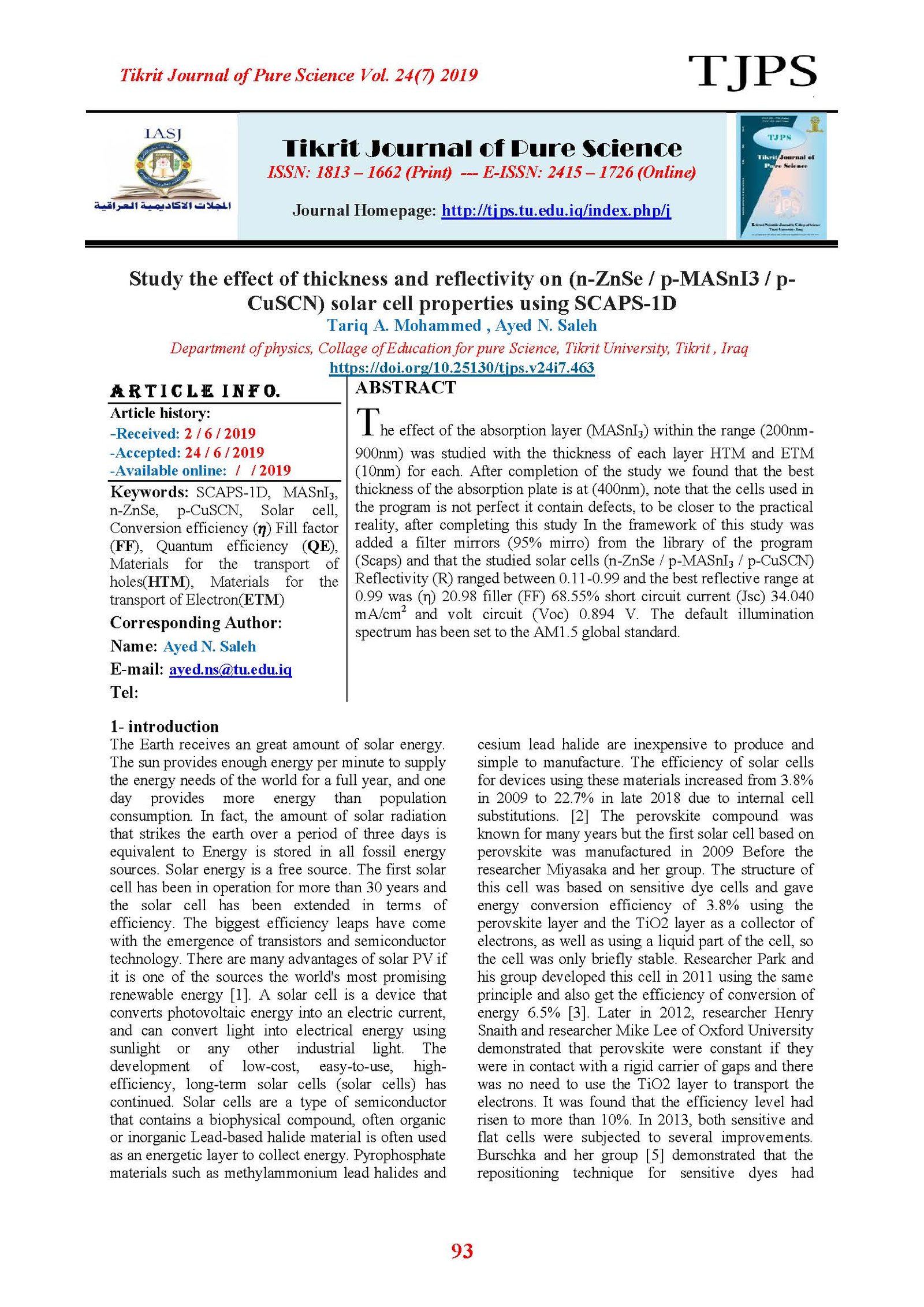Study the effect of thickness and reflectivity on (n-ZnSe / p-MASnI3 / p-CuSCN) solar cell properties using SCAPS-1D
Main Article Content
Abstract
The effect of the absorption layer (MASnI3) within the range (200nm-900nm) was studied with the thickness of each layer HTM and ETM (10nm) for each. After completion of the study we found that the best thickness of the absorption plate is at (400nm), note that the cells used in the program is not perfect it contain defects, to be closer to the practical reality, after completing this study In the framework of this study was added a filter mirrors (95% mirro) from the library of the program (Scaps) and that the studied solar cells (n-ZnSe / p-MASnI3 / p-CuSCN) Reflectivity (R) ranged between 0.11-0.99 and the best reflective range at 0.99 was (η) 20.98 filler (FF) 68.55% short circuit current (Jsc) 34.040 mA/cm2 and volt circuit (Voc) 0.894 V. The default illumination spectrum has been set to the AM1.5 global standard.
Article Details

This work is licensed under a Creative Commons Attribution 4.0 International License.
Tikrit Journal of Pure Science is licensed under the Creative Commons Attribution 4.0 International License, which allows users to copy, create extracts, abstracts, and new works from the article, alter and revise the article, and make commercial use of the article (including reuse and/or resale of the article by commercial entities), provided the user gives appropriate credit (with a link to the formal publication through the relevant DOI), provides a link to the license, indicates if changes were made, and the licensor is not represented as endorsing the use made of the work. The authors hold the copyright for their published work on the Tikrit J. Pure Sci. website, while Tikrit J. Pure Sci. is responsible for appreciate citation of their work, which is released under CC-BY-4.0, enabling the unrestricted use, distribution, and reproduction of an article in any medium, provided that the original work is properly cited.
References
[1] Fang, H.; Li, X.; Song, S.; Xu, Y.; and Zhu, J. (2008). Fabrication of slantingly-aligned silicon nanowire arrays for solar cell applications. Nanotechnology, 19(25): 255703.
[2] Babayigit, A.; Boyen, H. G.; and Conings, B. (2018). Environment versus sustainable energy: The case of lead halide perovskite-based solar cells. MRS Energy and Sustainability, 5.
[3] Im, J. H.; Lee, C. R.; Lee, J. W.; Park, S. W.; and Park, N. G. (2011). 6.5% efficient perovskite quantum-dot-sensitized solar cell. Nanoscale, 3(10): 4088-4093.
[4] Lee, M. M.; Teuscher, J.; Miyasaka, T.; Murakami, T. N.; and Snaith, H. J. (2012). Efficient hybrid solar cells based on meso-superstructured
organometal halide perovskites Science,. 338 (6107): 643-647. [5] Liu, M.; Johnston, M. B.; and Snaith, H. J. (2013). Efficient planar heterojunction perovskite solar cells by vapour deposition. Nature, 501(7467): 395.
[6] Docampo, P.; Ball, J. M.; Darwich, M.; Eperon, G. E.; and Snaith, H. J. (2013). Efficient organometal trihalide perovskite planar-heterojunction solar cells on flexible polymer substrates. Nature communications, 4: 2761.
[7] Zhou, H.etal.(2014). Interface engineering of highly efficient perovskite solar cells. Science, 345(6196): 542-546.
[8] Amu, T. L.; Abuja, N. (2014). performance optimization of tin halide perovskite solar cells via numerical simulation .
[9] Ahemad, M.;and kibret, M.(2014).Mechanisms andapplications of plant growth promoting rhizobacteria: current perspective Journal of kind saud university-science, 26 (1):1-20. [10] Vardhanan, R. V.; Zhou, L.; and Gao, Z. (1999). Schottky and heterojunction diodes based on poly (3-octylthiophene) and poly (3-methylthiophene) films of high tensile strength. Thin Solid Films, 350(1-2):
283-288.
[11] Pronko, P. P.; Van Rompay, P. A.; Horvath, C.; Loesel, F.; Juhasz, T.; Liu, X.; and Mourou, G. (1998). Avalanche ionization and dielectric breakdown in silicon with ultrafast laser pulses. Physical Review B, 58(5): 2387.
[12] Anwar, F.; Mahbub, R.; Satter, S. S.; and Ullah, S. M. (2017). Effect of Different HTM Layers and Electrical Parameters on ZnO Nanorod-Based Lead-Free Perovskite Solar Cell for High-Efficiency Performance. International Journal of Photoenergy, 2017.
[13] Correa, Baena, J. P.etal. (2016). Unbroken Perovskite: Interplay of Morphology, Electro optical Properties, and Ionic Movement. Advanced Materials, 28(25): 5031-5037.
[14] Tan, K., Lin, P.etal. (2016). Controllable design of solid-state perovskite solar cells by SCAPS device simulation. Solid-State Electronics, 126:75-80.
[15] Iefanova, A.; Adhikari, N.; Dubey, A.; Khatiwada, D.; and Qiao, Q. (2016). Lead free CH3NH3SnI3 perovskite thin-film with p-type semiconducting nature and metal-like conductivity. AIP Advances, 6(8): 085312.
[16] Dixit, H.; Punetha, D.; and Pandey, S. K. (2019). Improvement in performance of lead free inverted perovskite solar cell by optimization of solar parameters. Optik, 179:969-976
[17] Saidaminov, M. I. etal. (2015). High-quality bulk hybrid perovskite single crystals within minutes by inverse temperature crystallization. Nature communications, 6: 7586.
[18] Yuan, M.; Voznyy, O.; Zhitomirsky, D.; Kanjanaboos, P.; and Sargent, E. H. (2015). Synergistic doping of fullerene electron transport layer and colloidal quantum dot solids enhances solar cell performance. Advanced Materials, 27(5):917-921.
[19] Donald, A. N. (1992). Semiconductor Physics and Devices: Basic Principles. Irwin.
[20] Peijie L.; etal. (2014). Numerical Simulation of Cu2ZnSnS4 Based Solar Cells with In2S3 Buffer Layers by SCAPS-1D. Journal of Applied Science and Engineering, 17( 4):383-390
